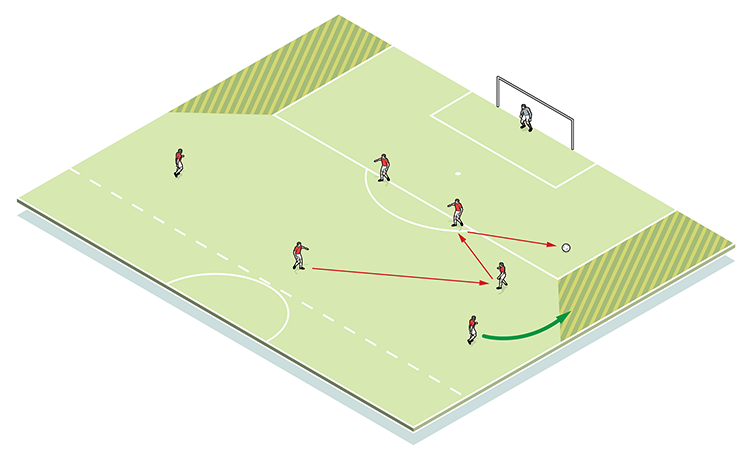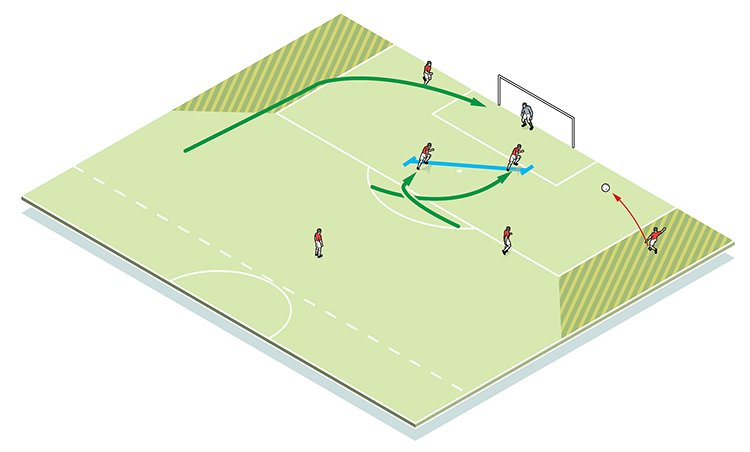Crosses from danger zones
This session looks at crossing the ball into the penalty area from advanced positions, also known as danger zones. These areas are crucial in the game because they’re so difficult for the opposition to defend.

| Area | Final third |
| Equipment | Balls, goals |
| No. of Players | 10 |
| Session Time | Session 20mins, development 20mins, game 20mins |
This session looks at crossing the ball into the penalty area from advanced positions, also known as danger zones. These areas are crucial in the game because they’re so difficult for the opposition to defend.
The aim of the practice is, of course, to find the net, but it features movement and positional play for attackers, wingers and midfielders too, with defenders involved in the opposed progressions.
The session we have outlined shows specific movement of one chosen scenario, though of course, variations of crossing and movement exist.
What do I get the players to do?
We set up initially with a six-man unopposed attacking move in the final third, plus a keeper. There is a midfielder (placed centrally), three wingers (two on one side) and two strikers (on the edge of the box).
In the chosen scenario, the midfielder plays out to one of the two wingers on the right. As soon as the winger’s first touch lays the ball to the nearest striker, the second winger overlaps into what we class as a crossing danger zone – namely, a 10-yard strip running the outside the 18-yard box – and crosses (1a).
1a

Both strikers must challenge for the ball, along with the third winger who approaches from the opposite flank. To reduce the chance of the cross beating the striking duo, striker 1 should run to the near post with striker 2 coming across behind him on a diagonal run (1b). Now rerun on the opposite flank.
1b

How do I progress the session?
For the next phase, we make one of the wingers a defender. The midfielder passes in to either of the two strikers, who must protect the ball from the defender and play it back (2a). It now goes wide to a winger, who takes a first touch into danger zone, before crossing. (2b)
2a

2b

In the second progression, an overlapping full-back comes into play. The midfielder feeds the ball out to the right and the winger’s touch takes him infield slightly. But the full-back overlaps,
receives the pass and crosses. (3a)
3a

In the centre is 2v2, defenders versus strikers, although attacking options can be increased by encouraging the opposite winger and midfielder to move in. (3b)
3b

What are the key things to look for technically/tactically?
Danger zones are key areas and we’ll reference them frequently in this session. In essence, we’re looking for players to adopt good body shape and to approach the ball with intelligent runs.
The strikers’ runs should be timed in order to meet the ball on the move.
For overlapping wingers, the full-back must not advance past the wide man until the pass is made, for fear of straying offside.
Editor's Picks
Attacking transitions
Deep runs in the final third
Using the goalkeeper in build-up play
Intensive boxes drill with goals
Penetrating the final third
Creating and finishing
My philosophy
Pressing initiation
Compact team movement
Coaches' Testimonials

Alan Pardew

Arsène Wenger

Brendan Rodgers

Carlos Carvalhal

José Mourinho

Jürgen Klopp

Pep Guardiola

Roy Hodgson

Sir Alex Ferguson

Steven Gerrard
Coaches' Testimonials

Gerald Kearney, Downtown Las Vegas Soccer Club

Paul Butler, Florida, USA

Rick Shields, Springboro, USA

Tony Green, Pierrefonds Titans, Quebec, Canada
Join the world's leading coaches and managers and discover for yourself one of the best kept secrets in coaching. No other training tool on the planet is written or read by the calibre of names you’ll find in Elite Soccer.
In a recent survey 92% of subscribers said Elite Soccer makes them more confident, 89% said it makes them a more effective coach and 91% said it makes them more inspired.
Get Monthly Inspiration
All the latest techniques and approaches
Since 2010 Elite Soccer has given subscribers exclusive insight into the training ground practices of the world’s best coaches. Published in partnership with the League Managers Association we have unparalleled access to the leading lights in the English leagues, as well as a host of international managers.
Elite Soccer exclusively features sessions written by the coaches themselves. There are no observed sessions and no sessions “in the style of”, just first-hand advice delivered direct to you from the coach.









